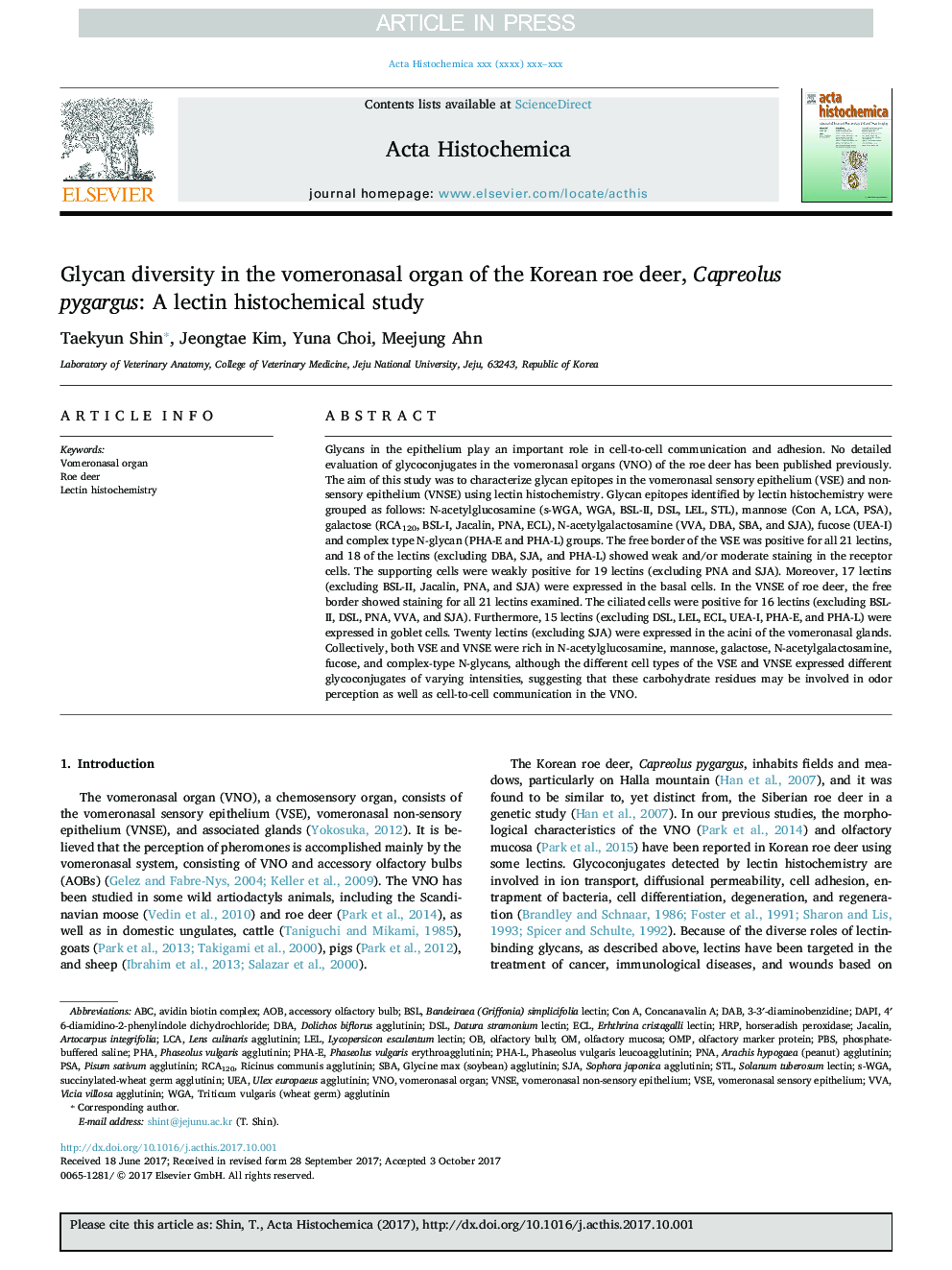| کد مقاله | کد نشریه | سال انتشار | مقاله انگلیسی | نسخه تمام متن |
|---|---|---|---|---|
| 8287586 | 1535859 | 2017 | 8 صفحه PDF | دانلود رایگان |
عنوان انگلیسی مقاله ISI
Glycan diversity in the vomeronasal organ of the Korean roe deer, Capreolus pygargus: A lectin histochemical study
دانلود مقاله + سفارش ترجمه
دانلود مقاله ISI انگلیسی
رایگان برای ایرانیان
کلمات کلیدی
Pisum sativum agglutininOMPPHA-Lavidin biotin complexABCWGASBAPHA-EUEARicinus communis agglutininPhaseolus vulgaris leucoagglutininVNOArtocarpus integrifoliaVVARCA120Dolichos biflorus agglutininPhaseolus vulgaris erythroagglutinin3-3′-diaminobenzidineSolanum tuberosum lectinSophora japonica agglutininSJASTLDABPBSConcanavalin ALELPHAAOBPSAPNAHRPDSLECLDBADAPIBSLVicia villosa agglutinin - Vicia villosa آگلوتینینulex europaeus agglutinin - آلکس یوروپس آگلوتینینLens culinaris agglutinin - آگلوتیینین آشپزی لنزLCA - ارزیابی چرخه حیاتvomeronasal organ - ارگان vomeronasalCon A - با AJacalin - جاکالینaccessory olfactory bulb - لامپ متلاشی کننده لوازم جانبیPhosphate-buffered saline - محلول نمک فسفات با خاصیت بافریOlfactory mucosa - مخاط بینیVSE - همهLectin histochemistry - هیستوشیمی لکتینHorseradish peroxidase - پراکسیداز هوررادیشolfactory marker protein - پروتئین مارکر بویاییolfactory bulb - پیاز بویاییRoe deer - گوزن کوچک
موضوعات مرتبط
علوم زیستی و بیوفناوری
بیوشیمی، ژنتیک و زیست شناسی مولکولی
زیست شیمی
پیش نمایش صفحه اول مقاله

چکیده انگلیسی
Glycans in the epithelium play an important role in cell-to-cell communication and adhesion. No detailed evaluation of glycoconjugates in the vomeronasal organs (VNO) of the roe deer has been published previously. The aim of this study was to characterize glycan epitopes in the vomeronasal sensory epithelium (VSE) and non-sensory epithelium (VNSE) using lectin histochemistry. Glycan epitopes identified by lectin histochemistry were grouped as follows: Nâacetylglucosamine (s-WGA, WGA, BSL-II, DSL, LEL, STL), mannose (Con A, LCA, PSA), galactose (RCA120, BSL-I, Jacalin, PNA, ECL), N-acetylgalactosamine (VVA, DBA, SBA, and SJA), fucose (UEA-I) and complex type N-glycan (PHA-E and PHA-L) groups. The free border of the VSE was positive for all 21 lectins, and 18 of the lectins (excluding DBA, SJA, and PHA-L) showed weak and/or moderate staining in the receptor cells. The supporting cells were weakly positive for 19 lectins (excluding PNA and SJA). Moreover, 17 lectins (excluding BSL-II, Jacalin, PNA, and SJA) were expressed in the basal cells. In the VNSE of roe deer, the free border showed staining for all 21 lectins examined. The ciliated cells were positive for 16 lectins (excluding BSL-II, DSL, PNA, VVA, and SJA). Furthermore, 15 lectins (excluding DSL, LEL, ECL, UEA-I, PHA-E, and PHA-L) were expressed in goblet cells. Twenty lectins (excluding SJA) were expressed in the acini of the vomeronasal glands. Collectively, both VSE and VNSE were rich in N-acetylglucosamine, mannose, galactose, Nâacetylgalactosamine, fucose, and complex-type N-glycans, although the different cell types of the VSE and VNSE expressed different glycoconjugates of varying intensities, suggesting that these carbohydrate residues may be involved in odor perception as well as cell-to-cell communication in the VNO.
ناشر
Database: Elsevier - ScienceDirect (ساینس دایرکت)
Journal: Acta Histochemica - Volume 119, Issue 8, October 2017, Pages 778-785
Journal: Acta Histochemica - Volume 119, Issue 8, October 2017, Pages 778-785
نویسندگان
Taekyun Shin, Jeongtae Kim, Yuna Choi, Meejung Ahn,